
PLM Fundamentals:
Refractive Index and Relief

|
What is Refractive Index? |
|
| Refractive Index
(RI) is the ratio of the speed of light in a vacuum compared to the
speed of light in another medium such as a mineral:
RI = (Speed of Light)VACUUM/(Speed of Light)MEDIUM |
|
 |
The RI of a vacuum is 1 and the RI of all other media is >1, with translucent minerals falling with the range of approximately 1.4 (opal) to 2.5 (diamond). |
|
How Do You Determine Refractive Index? |
|
 |
When light travels between two materials of different refractive index (such as air and water) the path of the light abruptly bends (refracts) or alternatively it may be reflected off of the interface between the media. It is this refraction and reflection of light that make the boundary visible to us. |
 |
If a mineral grain is immersed in a medium that has a different RI, then the refraction and reflection will allow us to see the grain clearly. |
|
|
|
 |
If a mineral is
immersed in a medium that has an identical RI, then there would be no
reflection or refraction from the edge of the mineral. Light would
travel through as if the mineral grain was not there.
In other words, the mineral grain would be invisible. |
|
|
|
 |
This relationship gives us a way to determine the RI of a particular grain: immerse the grain in a series of liquids with various known RI's and look at it through the microscope. If the grain stands out strongly, then the RI's are different. The more the grain appears to stand out of the immersion oil (i.e., the higher the RELIEF), the greater the difference in their RI's. |
| If the grain seems near invisible, then the RI of the mineral is approximately the same as that liquid. | |
 |
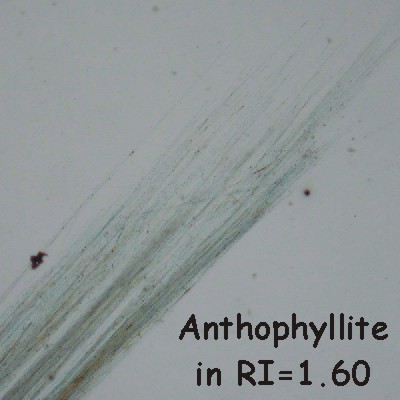 |
 |
| Anthophyllite
fibers stand out clearly in 1.55 RI Oil
RI of anthophyllite does not equal 1.55 |
Anthophyllite
fibers are subdued in 1.60 RI Oil
RI of anthophyllite is close to 1.60 |
Anthophyllite
fibers stand out clearly in 1.68 RI Oil
RI of anthophyllite does not equal 1.68 |
|
|
The various asbestos minerals have refractive indices of approximately 1.55, 1.60 or 1.68. Accordingly, when preparing samples for asbestos analysis the samples are immersed in oils with these three RI values. |
 |
In addition, dilute hydrochloric acid is also commonly used as an immersion medium in order to dissolve fine-grained calcite binding powder that masks the asbestos fibers. The RI of the acid is approximately 1.33. |

|
How to Determine Refractive Index on a Polarized Light Microscope |
|
|
|
Set up the microscope for plane polarized light (Analyzer Out) with any immersion medium |
 |
Note the relief of the grains. If they are almost invisible then the RI of the grains is approximately the same as the immersion oil |
 |
If the grains have significant relief, then try immersing the grains in another oil with a different RI |
 |
Repeat the process until you find the immersion oil in which the grains are almost invisible |
|
How would you describe the refractive index of the example mineral that is immersed in the six oils below? |
||
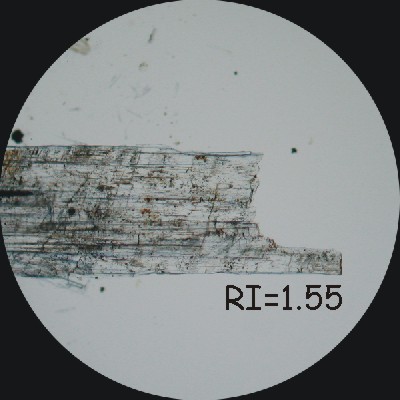 |
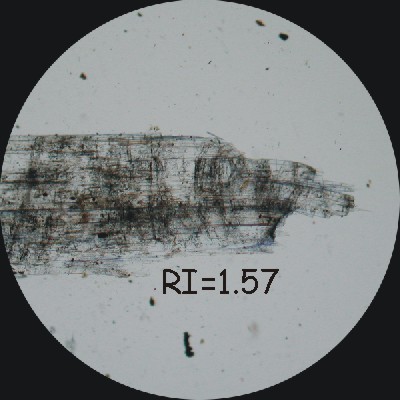 |
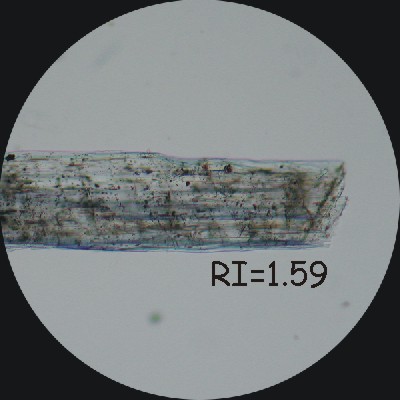 |
 |
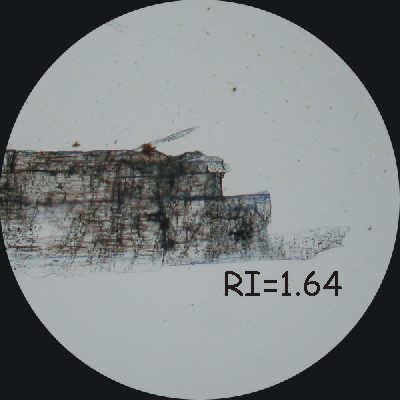 |
 |
|
To see how your description compares to the instructor's... |
||
